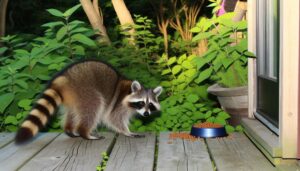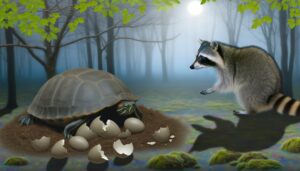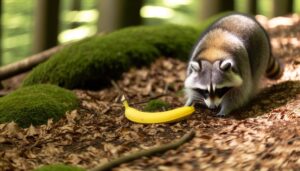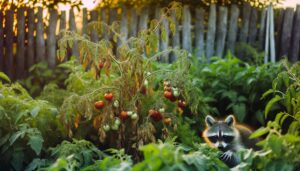Do Raccoons Eat Dead Raccoons?
Raccoons exhibit omnivorous and highly adaptable feeding behaviors. While cannibalism is rare, it does occur among various species, including raccoons.
Documented instances reveal that raccoons may consume dead conspecifics, driven by factors such as food scarcity and opportunistic survival strategies. Their solitary nature and varying social structures influence this behavior.
Similar to other adaptable species like bears and opossums, raccoons' dietary habits are shaped by ecological conditions, resource availability, and survival needs. Observations indicate that raccoons adopt such behaviors to meet their nutritional requirements in challenging environments.
There are additional factors that further elaborate this behavior.
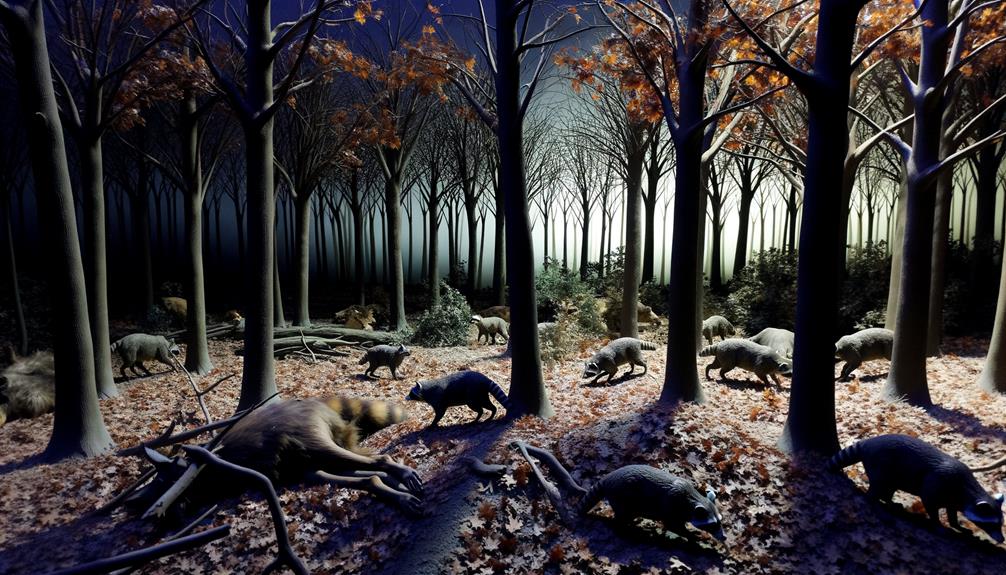
Key Takeaways
- Raccoons exhibit facultative scavenging behavior, which includes consuming dead raccoons when other food sources are scarce.
- Documented instances confirm that raccoons can engage in cannibalism under certain conditions.
- Raccoons' omnivorous and opportunistic diet allows them to adapt and consume available resources, including carcasses.
- Natural food scarcity and survival instincts drive raccoons to scavenge, sometimes leading to cannibalism.
- Post-mortem scavenging by raccoons has been observed, indicating a survival strategy in response to resource scarcity.
Raccoon Dietary Habits
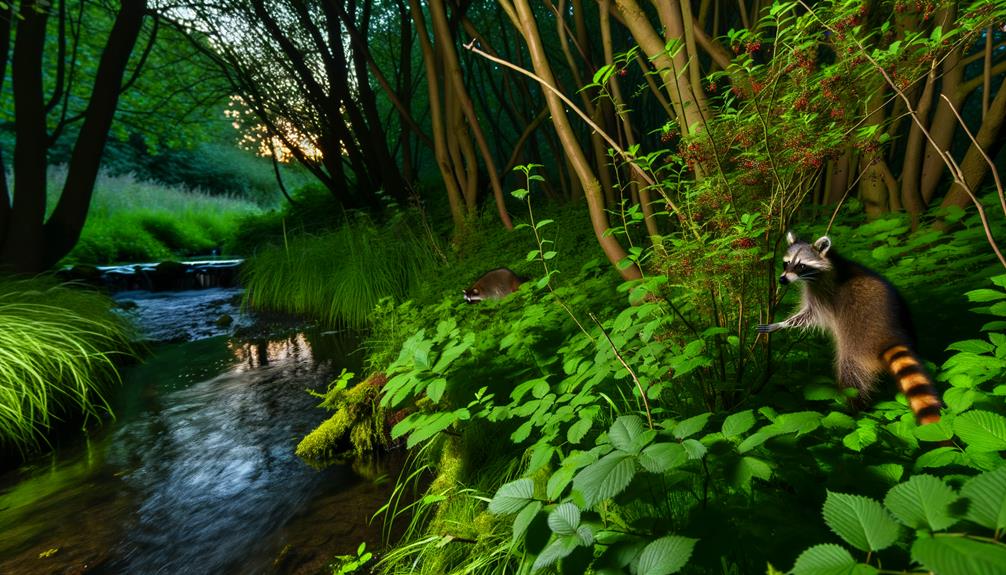
Raccoons (Procyon lotor) exhibit an omnivorous diet, consuming a wide range of food items that include fruits, nuts, insects, small mammals, and human-derived food waste. Their dietary adaptability is a key factor in their successful habitation across diverse environments, from urban areas to forests.
Studies indicate that raccoons adjust their food intake based on seasonal availability, with increased consumption of fruits and nuts in autumn and a preference for animal-based foods in spring. This opportunistic feeding behavior aids in their survival, allowing them to exploit various food sources.
Additionally, raccoons possess dexterous front paws that facilitate foraging and handling diverse food items, further enhancing their ability to thrive in fluctuating ecological conditions.
Cannibalism in Wildlife
Cannibalism in wildlife, though relatively rare, is a documented behavior observed across various species, including mammals, birds, and insects. This phenomenon can arise due to numerous factors such as environmental stress, scarcity of food resources, or social hierarchies.
Among mammals, instances of cannibalism have been recorded in species like lions, polar bears, and rodents. In birds, certain gull species and chickens exhibit this behavior, often linked to overcrowding or nutritional deficits. Insects, such as praying mantises and spiders, display cannibalism typically as a reproductive strategy or survival mechanism.
While this behavior may appear maladaptive, it can contribute to population control, resource optimization, and genetic diversity within a species, highlighting its complex ecological implications.
Evidence of Raccoon Cannibalism
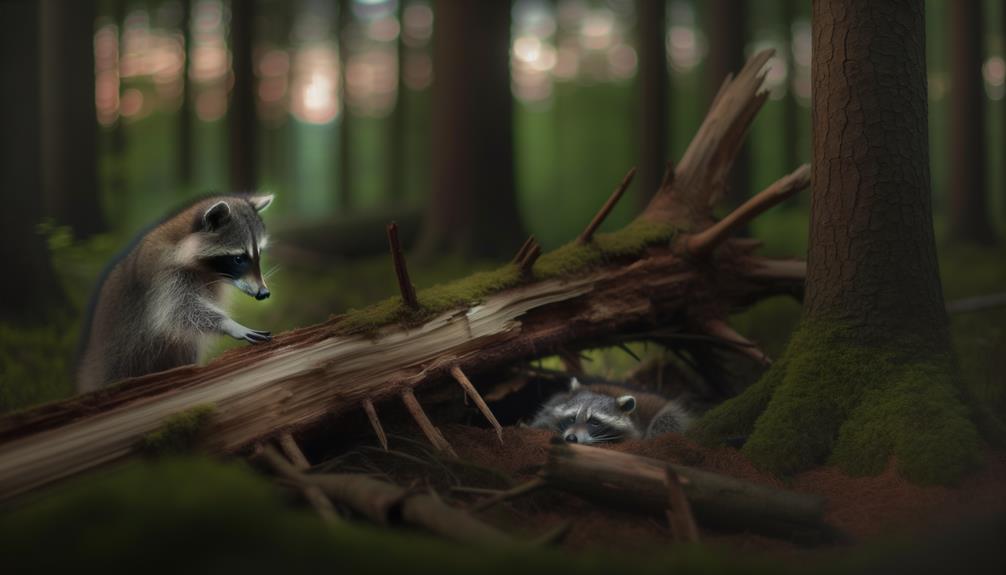
Documented instances of raccoon cannibalism, though not extensively studied, provide intriguing insights into the adaptive behaviors and survival strategies of this species. Observations in both controlled environments and natural settings have noted occurrences where raccoons consume deceased conspecifics.
Such behavior has been identified through direct observation and forensic analysis of raccoon remains, indicating post-mortem scavenging. These events are typically linked to periods of food scarcity or environmental stressors, suggesting a pragmatic response rather than a habitual practice.
Additionally, forensic evidence often includes characteristic bite marks and consumption patterns consistent with raccoon dentition. While these documented cases are sporadic, they offer valuable data points for understanding raccoon ecology and the complex factors influencing their dietary choices.
Survival Instincts
Survival instincts in raccoons are influenced by natural food scarcity and their opportunistic feeding behavior.
When conventional food sources become limited, raccoons may resort to consuming available carcasses, including those of their own species, to sustain themselves.
This behavior highlights their adaptability and resourcefulness in unpredictable environments.
Natural Food Scarcity
During periods of natural food scarcity, raccoons may exhibit adaptive behaviors driven by survival instincts, including the consumption of carcasses of their own species. This behavior, known as facultative scavenging, is a survival strategy that allows raccoons to obtain essential nutrients when preferred food sources are limited.
Nutritional stress during food scarcity can compel raccoons to exploit available resources, even those that are typically avoided, such as conspecific remains. This phenomenon has been documented in various mammalian species and is considered a pragmatic response to environmental pressures.
While not a primary dietary habit, the consumption of deceased raccoons can mitigate the adverse effects of starvation, highlighting the species' ecological plasticity and resilience in fluctuating habitats.
Opportunistic Feeding Behavior
Raccoons exhibit a high degree of opportunistic feeding behavior, driven by their innate survival instincts, which enables them to exploit a diverse range of food sources depending on availability and environmental conditions. This adaptability is a key factor in their survival across varied habitats.
Raccoons' diet includes fruits, nuts, small animals, and human refuse. In extreme circumstances, raccoons may engage in scavenging behaviors, including consuming carrion. This behavior is not unusual among omnivores and serves as a survival mechanism during periods of food scarcity.
The consumption of deceased conspecifics, although not common, can occur if other food sources are extremely limited. Such behaviors highlight raccoons' flexible foraging strategies and their ability to adapt to fluctuating environments.
Social Structure of Raccoons
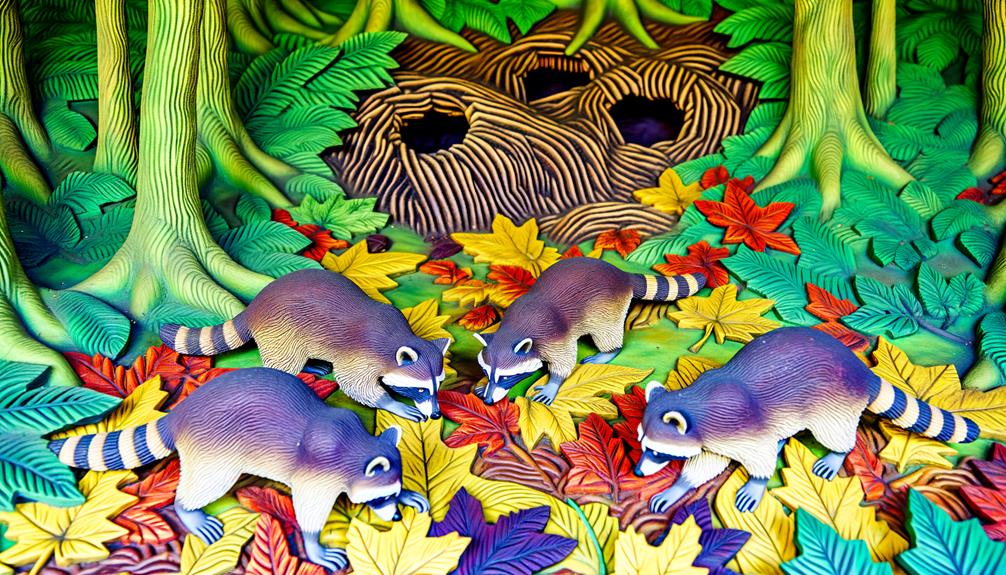
The social structure of raccoons is characterized by a solitary lifestyle, although females may form small, temporary groups during the breeding season. These groups typically consist of a mother and her offspring, who remain together until the young are sufficiently mature.
Adult males, conversely, are generally solitary, except during mating periods. Home ranges of raccoons are often overlapping, leading to occasional interactions, but these are usually non-social and driven by resource availability. Territoriality is minimal, with raccoons displaying a high degree of flexibility in their habitat use.
The solitary nature of raccoons is primarily influenced by their nocturnal habits and the need to efficiently exploit food resources, which are often dispersed and seasonally variable.
Scavenging Behavior
Raccoons exhibit natural scavenging instincts that are essential for their survival, particularly in environments with fluctuating food availability. Their opportunistic feeding habits enable them to consume a wide variety of food sources, including carrion.
Resource scarcity often compels raccoons to exploit available nutritional resources, which may include deceased conspecifics.
Natural Scavenging Instincts
Many mammals, including raccoons, exhibit natural scavenging instincts that drive them to consume carrion, thereby playing an important role in ecosystem nutrient cycling. These instincts are essential for various reasons:
- Ecosystem Health: Scavengers help decompose dead organisms, returning necessary nutrients to the soil.
- Disease Control: By consuming carrion, scavengers reduce the spread of diseases that could arise from decaying remains.
- Energy Efficiency: Scavenging requires less energy compared to hunting, allowing animals to conserve resources.
- Survival Adaptation: In times of food scarcity, scavenging can be an important survival strategy.
Raccoons, as opportunistic feeders, utilize their scavenging instincts to adapt to diverse environments, ensuring their survival and contributing to ecological balance.
Opportunistic Feeding Habits
Building upon their natural scavenging instincts, raccoons exhibit opportunistic feeding habits that enable them to exploit a wide range of food sources, including carrion, fruits, and human refuse. This adaptability is essential for their survival in diverse environments.
Their diet is highly varied and includes insects, small mammals, bird eggs, and aquatic organisms. Raccoons are also known to consume agricultural crops, making them both scavengers and foragers. They possess keen senses of smell and touch, allowing them to locate food efficiently.
Their opportunistic nature means they can switch food sources based on availability, which can include deceased animals they encounter. This versatile feeding behavior underscores their ecological role as both predators and scavengers, contributing to ecosystem balance.
Survival and Resource Scarcity
In conditions of resource scarcity, raccoons display heightened scavenging behavior as a survival strategy, utilizing their adaptability to locate and consume available food sources. This behavior is essential for their survival and can involve consuming carrion, including deceased conspecifics.
Several factors influence this behavior:
- Nutritional Need: Scavenging provides necessary nutrients when other food sources are limited.
- Environmental Pressure: Harsh conditions, such as winter, reduce the availability of typical food sources.
- Opportunistic Feeding: Raccoons are naturally opportunistic feeders, readily adapting to available resources.
- Reduced Competition: In scarce environments, the competition for food can drive raccoons to consume less preferred resources, including carrion.
These adaptive behaviors underscore raccoons' resilience in fluctuating environmental conditions.
Nutritional Needs
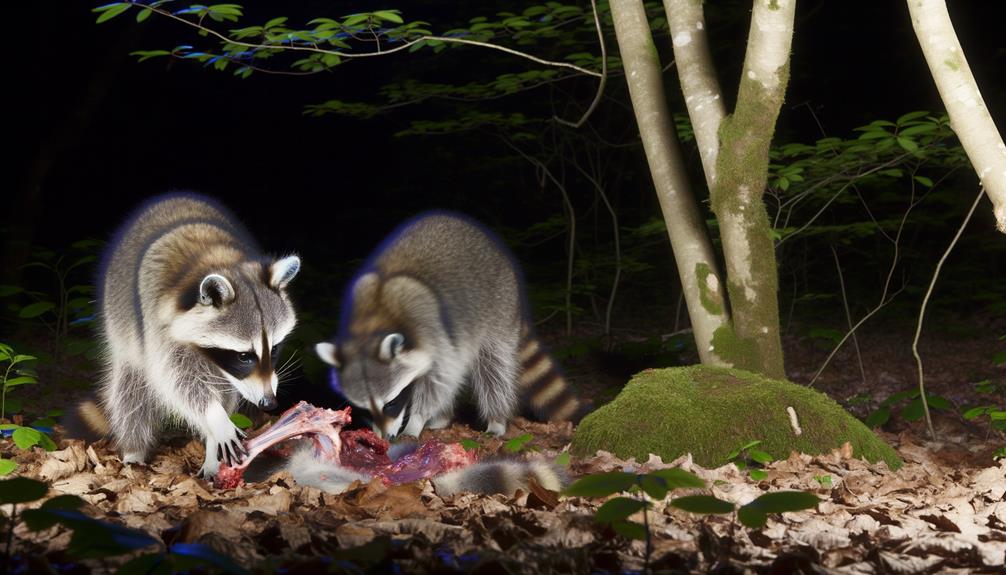
Understanding the nutritional needs of raccoons necessitates a detailed examination of their dietary requirements and habits. Raccoons are omnivores, consuming a varied diet that includes fruits, nuts, insects, small mammals, and aquatic organisms. Their diet changes seasonally to exploit available resources, maximizing caloric intake and nutritional diversity.
Essential nutrients for raccoons include proteins, fats, carbohydrates, vitamins, and minerals, which are critical for maintaining their energy levels, reproductive health, and overall physiological functions. Opportunistic feeding behaviors enable raccoons to adapt to diverse environments, from urban areas to wilderness.
Scavenging, including the consumption of carrion, provides additional nutritional benefits, especially in periods of resource scarcity, ensuring survival by supplementing their primary diet with readily available nutrients.
Comparing With Other Species
A comparative analysis of raccoons' dietary habits reveals both similarities and differences with other omnivorous species, such as bears and opossums, highlighting the adaptive strategies these animals employ to meet their nutritional needs. Raccoons, like bears and opossums, exhibit flexible eating behaviors that allow them to exploit diverse food sources. However, their scavenging tendencies show specific distinctions.
- Bears: Primarily consume vegetation, fish, and small mammals, but will scavenge carrion when available.
- Opossums: Opportunistic feeders that consume fruits, insects, and small animals, frequently scavenging dead animals.
- Raccoons: Omnivorous, consuming fruits, insects, and small animals, and occasionally scavenging carrion, including conspecifics.
- Adaptation: All three species adapt their diets based on seasonal availability and environmental conditions to maximize survival.
Environmental Factors
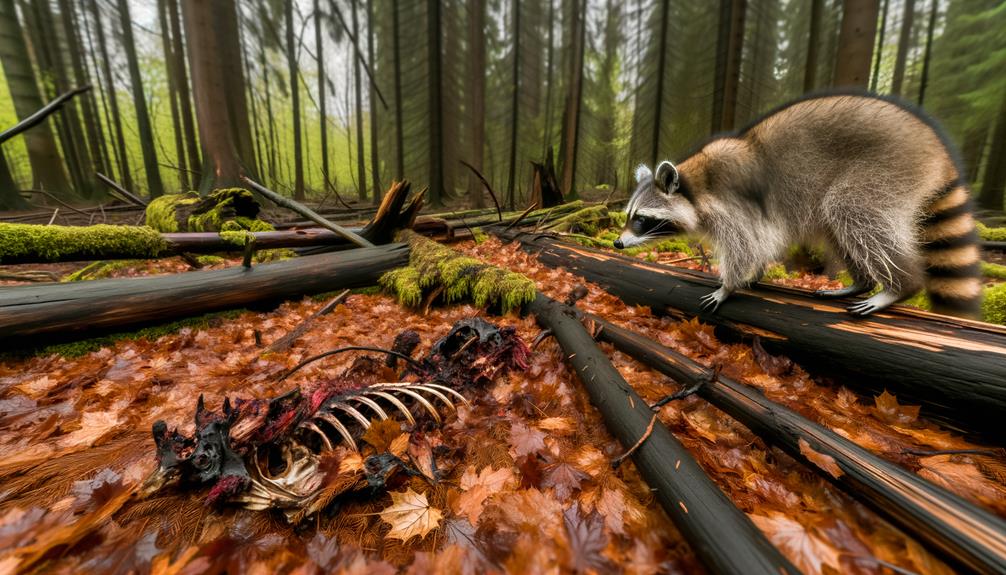
Environmental conditions profoundly influence raccoons' dietary choices. Factors such as habitat type, food availability, and human activity dictate the accessibility and variety of potential food sources. In urban environments, raccoons often exploit anthropogenic resources, relying on garbage, pet food, and other human-generated waste.
Conversely, in rural or forested habitats, their diet primarily consists of naturally occurring items such as fruits, insects, and small vertebrates. Seasonal variations also play a crucial role. During winter months, when food is scarce, raccoons may resort to opportunistic scavenging, including consuming carrion.
The interplay of these environmental elements can greatly enhance or limit the likelihood of raccoons encountering and consuming dead conspecifics, thereby influencing their scavenging behavior.
Human Observations
Numerous documented instances from wildlife researchers and urban dwellers provide valuable insights into raccoons' scavenging behaviors, including their occasional consumption of deceased conspecifics. Observations highlight several factors that may lead raccoons to engage in this behavior:
- Scarcity of Food Sources: In urban settings, limited access to other food may drive raccoons to scavenge from carcasses.
- Opportunistic Feeding Habits: Raccoons are known for their adaptability and may consume available resources, including carrion.
- Territorial Behavior: Encounters with deceased raccoons within their territory might prompt scavenging as a means of resource utilization.
- Observation by Humans: Increased urbanization has led to more frequent human observations of raccoon behavior, providing vital data on their scavenging patterns.
These insights help researchers understand the ecological and behavioral aspects of raccoon scavenging.
Conclusion
To sum up, raccoons, like many wildlife species, are subject to occasional cannibalistic behaviors driven by survival instincts, environmental pressures, and nutritional needs.
For instance, a study documented in a forested region of North America observed a raccoon scavenging on the carcass of a deceased conspecific, highlighting the opportunistic and adaptive nature of these animals.
Understanding such behaviors in raccoons provides insight into their social structure and dietary flexibility, and underscores the complex interactions within ecosystems.

